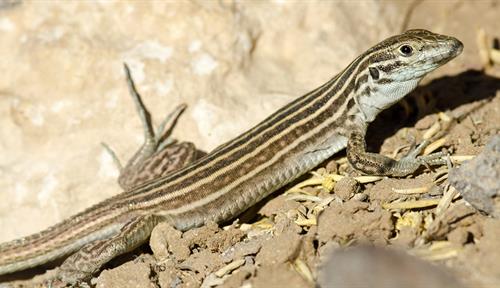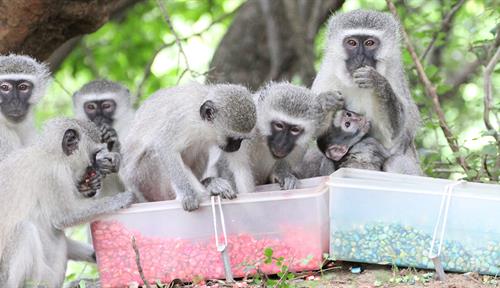Most amphibians aren’t exactly doting parents — they just find a partner and release as many eggs or sperm as possible, in hopes that viable larvae will hatch from at least some fertilized eggs, and at least some of those larvae will survive to adulthood.
Yet in as many as one in five amphibian species, one or both parents stick around to care for their offspring, using a staggering variety of strategies.
The most well-known amphibian parents are the brightly colored poison frogs, a group of around 200 species that will repeatedly be leaping into view in this article. Yet their parenting skills may not be as exceptional as once thought, says biologist Jennifer Stynoski of the University of Costa Rica, who decided to study this group when she spotted them on a field trip as a student years ago. “I think they’ve just received a lot of attention because they’re so beautiful. They’re very cute to study.”
So — what makes an exemplary amphibian parent? Much remains to be discovered, but some common principles have emerged.
Stay away from the water
Unlike reptiles and the birds that evolved from them, the ancestors of today’s amphibians never developed eggs with tough, watertight shells. This means their eggs need water to survive, as do the gilled larvae that usually come wriggling out.
Yet the ponds in which many amphibians deposit their eggs are full of other animals, many eager to supplement their diet by slurping up a mouthful of eggs. “This must be one reason why so many species have evolved ways to lay their eggs away from the water,” says behavioral ecologist Eva Ringler of the University of Bern in Switzerland.
In a recent article in the Annual Review of Ecology, Evolution, and Systematics, Ringler, Stynoski and colleagues describe the various places amphibians have evolved to lay their eggs. Some species build foam nests to keep their eggs afloat; others deposit them on plants above the water so that the larvae fall right in after they hatch. Some have taken things further: The wonderfully bizarre Surinam toad (Pipa pipa), for example, stores eggs in special brood pouches on its body.
Keeping eggs out of water is especially common in the humid tropics, where eggs, larvae and parents are less likely to dry out. “Yet amphibian parenting is not restricted to the tropics,” says Ringler. “The male of the midwife toad (Alytes obstetricans) here in Switzerland, for example, protects the eggs by carrying them between his hind legs.”

The male of the midwife toad (Alytes obstetricans, top) protects the eggs he fertilized by carrying them between his hindlegs. Females of the marbled snout-burrower (Hemisus marmoratus), also known as the shovel-nosed frog, can build a slide to help tadpoles to the water from an underground breeding chamber.
CREDITS: BERNARD DUPONT (TOP), KELLY ABRAM (BOTTOM) / WIKIMEDIA COMMONS
Work together (if you must)
Depending on the species, amphibian parental care is provided by father, mother or both. The evolved strategy is linked to the way that a species reproduces. Salamanders and newts are an interesting group to illustrate the importance of this, says evolutionary biologist Balázs Vági of the University of Debrecen in Hungary, who has done a number of studies comparing parenting styles across amphibians to understand how they may have come about.
In certain salamanders — ones believed to behave most similarly to the common ancestor of the entire group — eggs are fertilized outside the body, with the female laying eggs and the male releasing his sperm on top. In these species, males provide most of the care, which largely amounts to protecting the eggs from predators. “This makes sense,” Vági says, “because they are certain they’re the father, and females may be able to get away before fertilization is done.”
But in most salamander species as well as newts, the eggs are fertilized inside the female’s body, although somewhat indirectly: The male deposits a sperm package that the female then picks up with her cloacal opening. In this case, it’s often the male that departs and the female that cares for the offspring. “Parentage is more obscure, and the female is basically bound to the developing larvae,” Ringler explains, so males can get away to mate with other females. “Therefore, paternal care is very unlikely in internally fertilizing species.”
In poison frogs, fertilization happens outside the female’s body but usually away from the water. That makes quite a difference in the evolution of parenting strategy: It’s easier for a female to be sure that her chosen partner is the only one fertilizing her eggs — which can be tricky in a crowded pond — and for the male to be sure that the offspring are his.
This could be why coparenting evolved in these species. Males will very vocally defend a territory, and females will seek out a male with prime real estate for laying eggs in relative privacy. Each sex plays its role in care activities, but experiments have shown that if one parent disappears, the other may take over the work. Ensured of their paternity, males are especially keen to care for any eggs they find in their territory, whereas females are more picky.
Some amphibian parents collaborate with others of their kind. In some salamander species, females care for the eggs and young in a shared nest, quite possibly without knowing which of the little ones are their own. And in species like African foam-nesting tree frogs, a female will collaborate with multiple males to whip her secretions into a foam nest to lay her eggs in. While the males avoid the physical skirmishes common in other frogs, they all release their sperm into the same nest, and these sperm compete to fertilize the eggs.

Amphibians have evolved a wide variety of parental care behaviors both in the water and on land.
Keep on moving
Some amphibian species that lay their eggs on land skip the larval stage altogether, emerging from the mother fully formed. But many do hatch larvae, and these usually need help to find water. Females of the marbled snout-burrower, also called the shovel-nosed frog (Hemisus marmoratus), lay eggs in underground breeding chambers and may later build a slide to help larvae move to the water.
Some frogs transport tadpoles on their backs. “We see huge diversity in how different poison frogs manage this task,” says Ringler. Some species, such as the brilliant-thighed poison frog (Allobates femoralis) that she studies in French Guiana, carry lots of tadpoles at once over to a large body of water. Others, like the strawberry poison frog (Oophaga pumilio) that Stynoski researches in Costa Rica, carry them one by one to small pools of standing water, such as those that collect between the leaves of bromeliad plants high in the trees.
Bring snacks
These tiny pools of rainwater on plants often contain little or no food, which is why some frog parents have evolved to feed their offspring. Female strawberry poison frogs regularly visit the pools containing their young to lay unfertilized eggs that their tadpoles then eat. “Research has shown the eggs are essential for offspring survival,” Stynoski says, “and also transfer protective poison to the larvae.” In other frog species, eggs aren’t essential but function as supplementary food.
Perhaps the most remarkable ways of feeding offspring are found in the least-known group of amphibians, the limbless, worm-like caecilians, which spend much of their lives belowground, feeding on worms and insects. “Like other amphibians, caecilians support their young in various ways,” says biologist Alex Kupfer of the State Museum of Natural History in Stuttgart, Germany. “But in some species, we’ve found something truly unique: Females store lipids and sugars in outer skin layers that they then shed as food for their young.”
As if that wasn’t enough, a recent study in Science reports that in the egg-laying ringed caecilian (Siphonops annulatus), the mother secretes a milky substance from her cloaca that the hatchlings soon consume. It appears that she does so in response to the physical touch, and perhaps sound signals, of her offspring.

Hatchlings of the ringed caecilian (Siphonops annulatus) feed on a milk-like substance released from the mother’s cloacal opening.
CREDIT: PHOTO BY CARLOS JARED
Why not invite them in?
Even stranger, perhaps, are a number of caecilian species, such as the Rio Cauca caecilian (Typhlonectes natans), as well as a few salamanders, in which eggs hatch within the female. In some caecilians, the young then feed on cells or secretions from a nutritious structure in her oviduct. Such an arrangement has not been found in other amphibian groups, though a number of species are viviparous, with live young emerging from the reproductive tract. Though this limits the number of offspring a female can produce, it also enhances their chances of survival.
This is often seen in species living in very harsh environments, such as alpine salamanders in areas that may be covered in snow 10 months a year, says Ringler. “There, the only viable strategy is to retain the larvae in the body as long as possible and give birth to fully developed young.”
Some amphibian species even ingest their offspring. The male of Darwin’s frog (Rhinoderma darwinii) keeps eggs in his vocal sac until they hatch. “If you’ve never seen a video of this, you should watch it,” says Stynoski. “He basically vomits up little baby frogs.”
Don’t go extinct, please
Sadly, a closely related species from Chile, Rhinoderma rufum, which vomits tadpoles, is critically endangered, perhaps even extinct. And two unique Australian frog species in which females would harbor tadpoles in their temporarily inactivated stomachs are now undoubtedly gone. “It’s always tragic to lose a species,” says Vági, “but to lose such unique behaviors feels even worse.”
In the face of habitat destruction and climate change, some amphibian parents may be able to help their offspring survive by keeping them safely inside, moving them around or providing extra food. But many of these fantastically complex behaviors, and the species that depend on them for survival, are probably very vulnerable to environmental change.
“Because of their different life stages, amphibians need different habitats and different kinds of food throughout their lives,” says Ringler, and the loss of just one of these may imperil them. “Globally, they’re the most threatened vertebrate group. We really need to take better care of them.”






